The structure and organization of lanceolate mechanosensory complexes at mouse hair follicles
- PMID: 24569481
- PMCID: PMC3930909
- DOI: 10.7554/eLife.01901
The structure and organization of lanceolate mechanosensory complexes at mouse hair follicles
Abstract
In mouse hairy skin, lanceolate complexes associated with three types of hair follicles, guard, awl/auchene and zigzag, serve as mechanosensory end organs. These structures are formed by unique combinations of low-threshold mechanoreceptors (LTMRs), Aβ RA-LTMRs, Aδ-LTMRs, and C-LTMRs, and their associated terminal Schwann cells (TSCs). In this study, we investigated the organization, ultrastructure, and maintenance of longitudinal lanceolate complexes at each hair follicle subtype. We found that TSC processes at hair follicles are tiled and that individual TSCs host axonal endings of more than one LTMR subtype. Electron microscopic analyses revealed unique ultrastructural features of lanceolate complexes that are proposed to underlie mechanotransduction. Moreover, Schwann cell ablation leads to loss of LTMR terminals at hair follicles while, in contrast, TSCs remain associated with hair follicles following skin denervation in adult mice and, remarkably, become re-associated with newly formed axons, indicating a TSC-dependence of lanceolate complex maintenance and regeneration in adults. DOI: http://dx.doi.org/10.7554/eLife.01901.001.
Keywords: hair follicle; lanceolate complex; low-threshold mechanoreceptor (LTMR); terminal Schwann cell (TSC).
Conflict of interest statement
The authors declare that no competing interests exist.
Figures



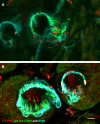

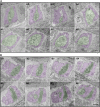



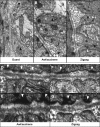



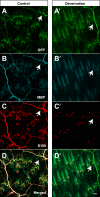

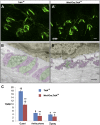

References
-
- Banks RW, Cahusac PM, Graca A, Kain N, Shenton F, Singh P, Nja A, Simon A, Watson S, Slater CR, Bewick GS. 2013. Glutamatergic modulation of synaptic-like vesicle recycling in mechanosensory lanceolate nerve terminals of mammalian hair follicles. Journal of Physiology 591:2523–2540. 10.1113/jphysiol.2012.243659 - DOI - PMC - PubMed
Publication types
MeSH terms
Substances
Grants and funding
LinkOut - more resources
Full Text Sources
Other Literature Sources
Molecular Biology Databases

